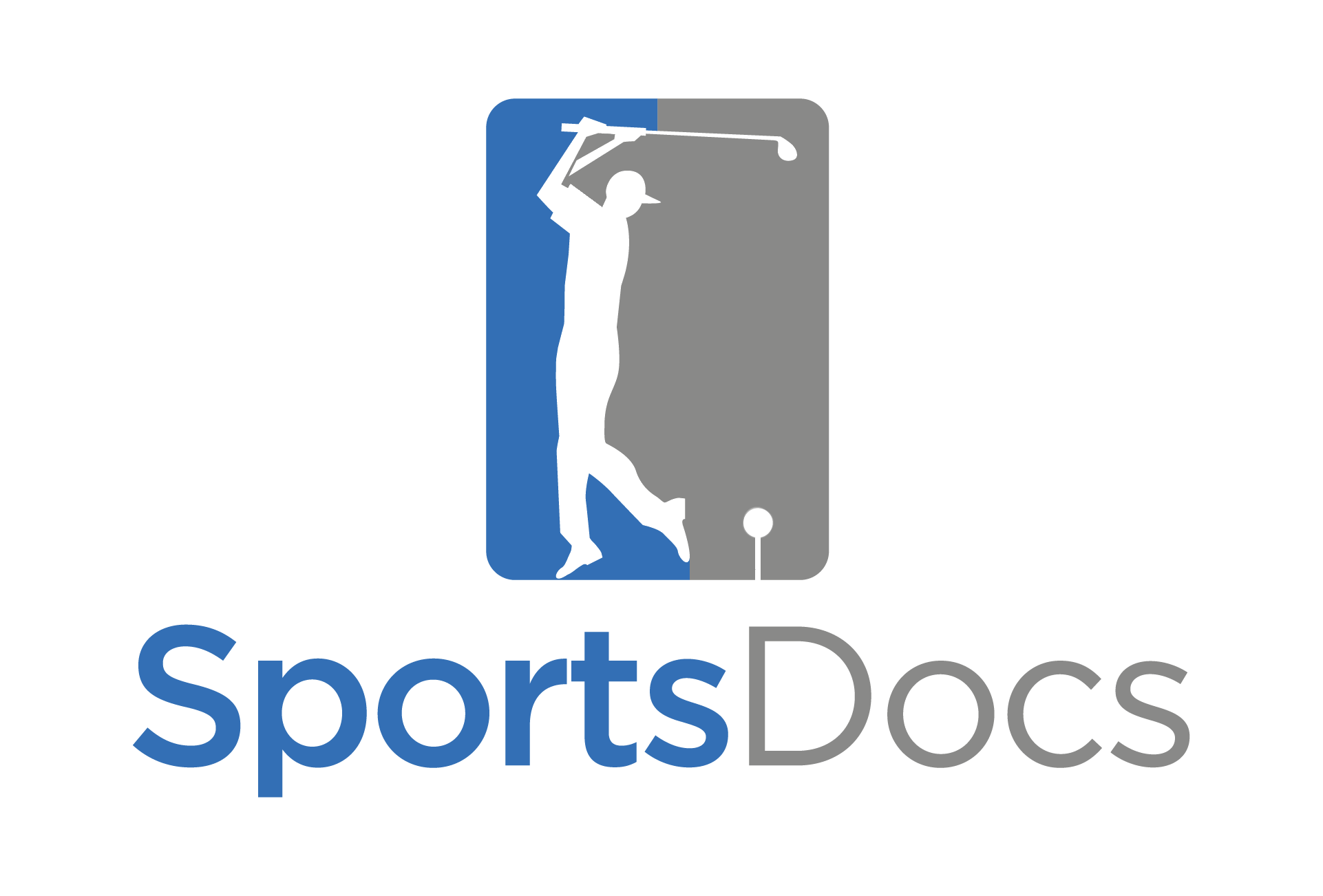The acromio-clavicular joint is between the clavicle (collar bone) and the acromion (shoulder bone). This injury usually results from a fall onto the tip of the shoulder or on to the back of the shoulder. The acromion is driven downwards and the tip of the clavicle remains behind; this results in tears of ligaments which normally hold them together (Figure 1). Although the injury usually appears like the collar bone is pointing into the air, it is actually the other way around, with the shoulder blade hanging down. The injury is graded into different types depending upon the number of ligaments torn and direction of the dislocation.
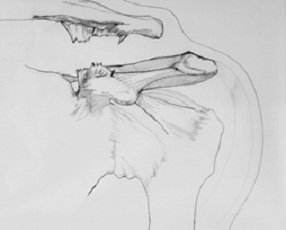
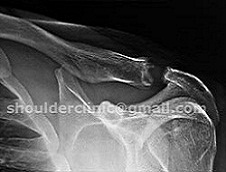
ANATOMY :
There are 3 stabilizing ligaments around the AC joint:
Acromio-clavicular (AC) ligaments, (the capsule of the joint),
Coraco-clavicular (CC) ligaments (conoid and trapezoid).
Types (Grades) of dislocation:
- Type I: Mild subluxation only involving a sprain of the capsular ligament.
- Type II: This is a tear of the capsular ligament but the important coraco-clavicular ligaments may still be intact.
- Type III: The coraco-clavicular and capsular ligaments are torn. This is the most common injury.
- Type IV: The tip of the clavicle is displaced to the rear.
- Type V: This is a severe upward displacement with the tip of the clavicle protruding up through the overlying trapezius muscle.
- Type VI: This is a downward displacement of the clavicle.
These injuries are common in sports and are often due to impact on the shoulder. Type III is commonly encountered in clinical practice.
CLINICAL PRESENTATION :
AC joint dislocation results in a “bump” on the shoulder , and in due course of time this may be associated with pain or discomfort in the shoulder and upper limb. This is usually due to the fact that the shoulder blade is displaced downwards, pulling on the nerves above the shoulder as well as the muscles stabilising the scapula – causing symptoms into the shoulder and down the arm. (This type of displacement of the scapula or shoulder blade is referred to as “winging of the scapula”) Lameness, tingling of fingers and pain at the back in the area of the shoulder blade may result.This lame, tired, aching feeling is often relieved by supporting the elbow and relieving the downward traction of the arm. Carrying bags in the hand with the arm by the side also aggravates the pain down the arm.
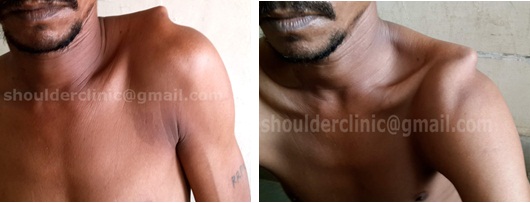
MANAGEMENT:
- Type I and II: Does not require surgery.
Patients with these injuries usually experience pain over the AC joint and there is swelling. They are usually managed conservatively and surgery is not necessary. Conservative treatment includes ice, rest and physiotherapy. A shoulder sling is not necessary to aid healing of the ligaments. The recovery is usually full with return to full and painless activity within a few weeks. Return to sport and other activities is safe as soon as the pain has settled.
- Type III: Does not require surgery in the majority of cases and can be managed conservatively. Surgical treatment is recommended if the patient wishes to avoid a “bump” like appearance.
- Type IV and V: Early repair of these dislocations is usually indicated. These patients usually have a lot of pain due to the fact that the tip of the collar boner protrudes into the overlying trapezius muscle and non- operative management does not have a favourable outcome
SURGERY FOR AC DISLOCATION :
All AC joint dislocations can be treated with arthroscopic (keyhole) surgery.
In the early period (UPTO 3 WEEKS ) after injury, the torn ligaments have the potential to heal completely, and simple approximation is performed using a TIGHTROPE device with keyhole surgery.
This device consists of a strong stitch that pulls the clavicle down to the correct position.
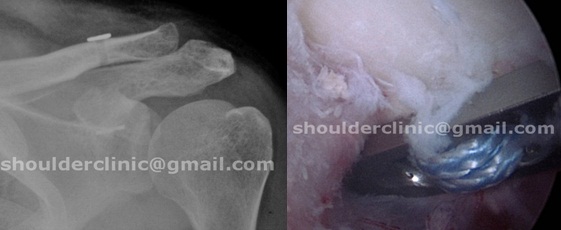 The TIGHTROPE device involves 2 metallic buttons, and these are placed through tunnels drilled into two bones.
The TIGHTROPE device involves 2 metallic buttons, and these are placed through tunnels drilled into two bones.
Recently, Dr Bhatia has developed a new procedure which does not need any metallic buttons , and does not involve drilling into bones.
This technique involves a simple “INTERNAL BRACING” and is performed through keyhole surgery.
INTERNAL BRACING :
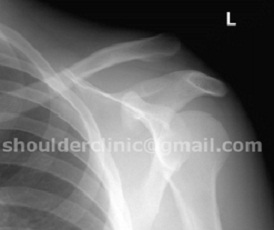
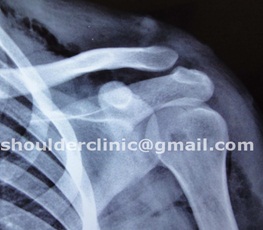
In the Late period (after 3-6 weeks), the torn ligaments gradually lose their healing potential. In such cases, the ligaments are reconstructed using a tendon graft obtained from the knee, or from a tissue bank. This procedure is also performed arthroscopically (keyhole) by Dr Bhatia.
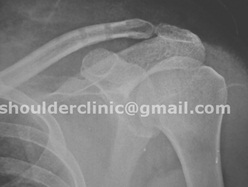
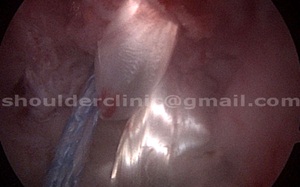
The purpose of this procedure is to not only realign the AC joint but also realign the shoulder blade to take the tension off the nerves of the brachial plexus. This realignment of the shoulder blade relieves the traction on the nerves and cures the symptoms in the arm.
This procedure is usually very successful. The patient usually stays in the hospital one night after the procedure and be discharged the next morning in a shoulder sling.
POST – OPERATIVE REHAILITATION :
The sling is worn for about 3 weeks and during this post-operative period, the patient is permitted to do movements of the arm without stressing it. Gradual motion to normal activities will be permitted under supervision of the doctor and the physiotherapist.
Everyday activities like dressing, driving etc are permitted. Return to work will be very soon for people in less stressful occupations
Pain following the procedure is usually minimal and the symptoms down the arm are relieved soon after the operation
The success rate of this procedure has been very high with full return to pre-injury activities.

